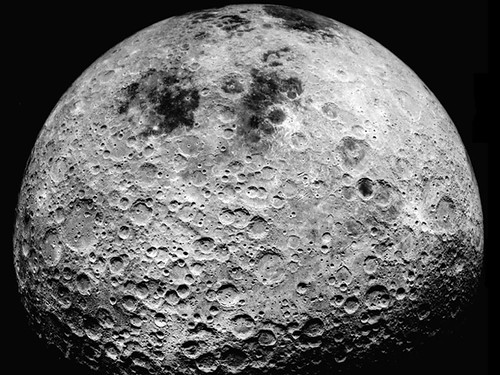Blueshift ponders… what’s one misconception in astronomy that drives you crazy?
- By Maggie Masetti
- May 10, 2013
- 5 Comments
Blueshift has covered the bad science in movies. In today’s “Blueshift Ponders,” we asked several of our colleagues:
What’s one misconception in astronomy drives you crazy?
Here are are their answers! What are yours? Tell us yours either in the comments, or on Facebook or Twitter!
Korey Haynes: The “dark” side of the moon misnomer. It’s just the far side! But I think the misleading terms people use contribute to why it’s so hard for most people to understand how the moon moves with respect to us and the sun. Maybe we need to launch a campaign to make Gary Larson more famous than Pink Floyd?

The far side of the moon, Credit: Apollo 16 Crew, NASA
Brian Williams: The misconception that drives me crazy is how people view scientists in general from a societal standpoint. The “stereotypical” scientists are socially awkward geeks (usually male) who could easily be picked out of a crowd of “normal” people. Television shows and movies don’t do anything to help here, with shows like The Big Bang Theory (which I do generally like, but still) reinforcing these stereotypes to the extreme (4 nerdy scientists who hang out with a pretty blonde girl). As funny as shows like this are, the fallacy being promoted is that you can be cool or you can be smart, but you can’t be both. In truth, we’re just like everyone else, and some of us are actually pretty cool people. :)
Koji Mukai: “Astronomy is the science of images” (or something along these lines), when spectroscopy is significantly more important as a source of scientific progress.
Maggie Masetti: People not understanding the vast distances in space. I don’t think people get how far away or how long it would take just to travel to the closest star to us. Even traveling at the speed of light it would take us over 4 years to get to Proxima Centauri. At the speed the Voyager spacecraft is moving, it would take over 73,000 years! Space is very, very big. (I tried to illustrate distances in space with this little Cosmic Distance Scale feature.)
Sara Mitchell: The idea that we need to go out into space to explore it. We’ve learned nearly everything that we know about the Universe from light that we collect, not by going out and directly measuring or sampling things. Sure, it’s nice to send a probe or a rover (or, very rarely, people), but that’s only reasonable for nearby objects (and still quite tricky). The Hubble Space Telescope creates amazingly detailed images of objects far, far away… as it orbits just a couple hundred miles above the Earth! It doesn’t have to go anywhere to capture those images, it just orbits Earth and patiently collects enough light to give us these details.
As it happens, our Nobel Laureate, Dr. John Mather (whom we’ve interviewed a few times) answered this question during the Reddit AMA that he did. Here is his answer:
John Mather: I think people have a really hard time grasping how empty outer space is, in the sense of immense distances between objects, and immense time spent going from one to another. There’s a lot of talk about space aliens as though it were physically possible for them to get here from somewhere else, and (sorry to say this) talk about human travel out of the solar system. We just don’t live long enough to do that.
It’s your turn! Comment below or drop us a line on Twitter or Facebook and tell us what misconceptions drive you crazy!



What drives ME crazy (actually, ‘wanting to chew nails’) is that TV shows like ‘The Universe’ and others constantly treat gravity as if it were the only force in the universe. Isn’t that actually CREATING a misconception? Granted, extremely complex subjects that even the world’s most intelligent minds don’t fully understand are being simplified for television but give the average viewer a little more fuel for thought. Fascinate me more.
The misconception that drives me crazy, is the idea that the moon does not rotate. Many people believe this because the same side of the moon always faces the Earth. :)
Gladys – That’s a classic misconception! I’ve found it really helpful to act out the Earth-Moon relationship, like with a globe and a golf ball, to demonstrate things like synchronous rotation.
I am not sure if you would call it a misconception, but, what bothers me is when scientists in any field speak of theories like they are facts.
Glen – I’d definitely call that a misconception! There are many people who are confused by the differences between hypotheses, theories, and facts. It doesn’t help that people don’t always use these terms consistently… and that there are theories with widely differing levels of acceptance or validation.
On the other side of things, it drives me crazy when people dismiss theories out of hand without considering the amount of evidence that may support them.